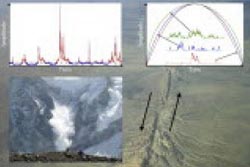An earthquake or a snow avalanche has its own shape

Earthquakes (the picture shows the San Andreas fault) and snow avalanches (an avalanche in Mount Everest shown on lower left corner) are examples of systems exhibiting bursty avalanche dynamics. Individual bursts have a highly irregular, complex structure (upper left corner). However, they have also a typical, well-defined average shape which depends on certain fundamental properties of the system, i.e. its universality class in the language of physics (upper right corner).<br><br>Credit: Aalto University<br>
Avalanches of snow or earthquakes can be described in other ways than the well-known Gutenberg-Richter scale, which gives a prediction of how likely a big avalanche or event is.
Each avalanche or burst has its own typical shape or form, which tells for instance when most snow is sliding after the avalanche has started. The shape of can be predicted based on mathematical models, or one can find the right model by looking at the measured shape.
– We studied results from computer simulations, and found different kinds of forms of events. We then analyzed them with pen and paper, and together with our experimental collaborators, and concluded that our predictions for the avalanche shapes were correct, Mikko Alava explains.
The results can be applied to comparing experiments with simplified model systems, to a much greater depth. The whole shape of an avalanche holds much more information than say the Gutenberg-Richter index, even with a few other so-called critical exponents.
Link to the Nature Communications article: http://www.nature.com/ncomms/2013/131219/ncomms3927/full/ncomms3927.html
Contact information:
Professor Mikko Alava
mikko.alava@aalto.fi
Tel. +358 50 4132152
Academy Research Fellow Lasse Laurson
lasse.laurson@aalto.fi
Tel. +358 50 4333671
The research group http://physics.aalto.fi/groups/comp/csm/ is part of the Finnish Computational Nanoscience Centre of Excellence (COMP) http://physics.aalto.fi/groups/comp/
Department of Applied Physics
Aalto University School of Science
Media Contact
More Information:
http://www.aalto.fiAll latest news from the category: Earth Sciences
Earth Sciences (also referred to as Geosciences), which deals with basic issues surrounding our planet, plays a vital role in the area of energy and raw materials supply.
Earth Sciences comprises subjects such as geology, geography, geological informatics, paleontology, mineralogy, petrography, crystallography, geophysics, geodesy, glaciology, cartography, photogrammetry, meteorology and seismology, early-warning systems, earthquake research and polar research.
Newest articles

“Nanostitches” enable lighter and tougher composite materials
In research that may lead to next-generation airplanes and spacecraft, MIT engineers used carbon nanotubes to prevent cracking in multilayered composites. To save on fuel and reduce aircraft emissions, engineers…

Trash to treasure
Researchers turn metal waste into catalyst for hydrogen. Scientists have found a way to transform metal waste into a highly efficient catalyst to make hydrogen from water, a discovery that…

Real-time detection of infectious disease viruses
… by searching for molecular fingerprinting. A research team consisting of Professor Kyoung-Duck Park and Taeyoung Moon and Huitae Joo, PhD candidates, from the Department of Physics at Pohang University…




















